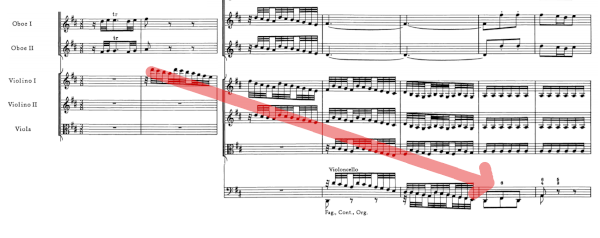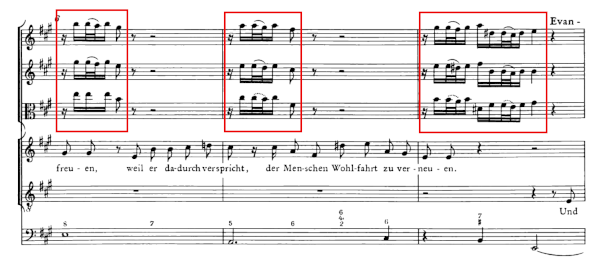Bach, Christmas Oratorio; Parts 1 and
Parts 5, BWV 248. T.
Herbert Dimmock introduces the Christmas
Oratorio with comments on the opening and then discussion of
several
examples from Part 5. BDP #268. http://bachinbaltimore.org/
Johann Sebastian Bach’s
lifetime work was actually the
writing of cantatas. We know his wonderful organ pieces. We certainly
know his
instrumental music, even though there is not nearly as much of it. Bach
in his
lifetime probably wrote 300 or more cantatas, each of which are about
twenty
minutes long. Bach lived from 1685 to 1750. At the absolute height of
his
powers, when he was in Leipzig in 1734, he wrote six cantatas that
stick
together into a whole, which is called the Christmas
Oratorio.
The Christmas Oratorio is a wonderful piece. I can’t tell you enough how I love the way it starts. How many pieces start with just the tympani playing by itself? Well, the Christmas Oratorio does. It is a signal motif that says, “Wake up!” as the timpani (music) has a little fanfare motive. It is interesting to me that the orchestra wakes up one at a time. First the flutes, they wake up. (music). Then the tympani plays. (music) Then the oboes wake up. (music) Then the tympani comes back. (music) Now the strings come in—this is so magnificent. They start at the highest note possible and it comes down, rip roaring through the strings, passed over to the violas, then the cellos, and then the basses. Of course, the double bass plays down the extra octave. There is this spectacular five-octave scale that takes place in the course of four measures. In a fast tempo it is a picture of God crashing down from heaven above to earth below.

That is the first beginning of the Christmas Oratorio. The Christmas
Oratorio is six cantatas written for Christmas. Christmas day
1, Christmas
day 2, Christmas day 3, Christmas the Feast of the Naming of Jesus also
called
the Feast of the Circumcision, the first Sunday in the New Year, and
the Feast
of the Epiphany--six cantatas.
On the first Sunday of the New Year,
we get Cantata 5. First
of all, let’s talk about how the piece is put together. In
this particular
Cantata Bach features the oboe d’amore. The oboe
d’amore is one of Bach’s
favorite instruments. It is not an instrument that we use much in the
modern
orchestra today. If you think of the regular oboe as this big, and you
think of
the English horn as this big, then the oboe d’amore is in the
middle. It has a
bell-shape bottom. It has a beautiful dark sound that Bach so loved.
The text is “Ehre sei dir, Gott, gesungen” “Honor be sung to Thee, oh Lord.” This opening melody is first given by the oboes. They play it in a way that talks about how we should sing it to the Lord. The Lord, of course, is in heaven above. So, the oboe d’amore… (music) the oboe d’amore directs our attention to where praise should be sung. It starts way down here (low note) and ends way up here (high note). Bach is directing through the instruments; the instruments are presenting a commentary on where the praises should be sung. When the singers come in they sing a melody that goes up. When they get to a word “Lob,” which is German for praise, there is wonderful exuberant quality to the word “Lob.” It goes upward. It goes up in a way that is eager to do so.

You would think…(counting and singing) but Bach goes
… (counting,
singing, and playing). He leaps in early because there is an eagerness
in
giving the praise. The word Lob goes up (music). The second word is
“Dank” and
again in the word “Dank” that comes with the word
praise we have lightness, a
quality of thanks that goes upward.
Why do we call this the Christmas
Oratorio instead of just six cantatas? This is one reason
alone and one
reason only. It is because the tenor soloist is given a name. He is
called an
“Evangelist.” The tenor soloist sings the text of
the Bible that tells the
story. For that reason, to differentiate it from the other cantatas
where all
of the singers are just called, “soprano, alto, tenor, or
bass” we call this an
oratorio.
Bach was a deeply religious person. He was what was called a pietistic Lutheran, a “heart on your sleeve,” a profoundly religious person. In the Christmas story at this point King Herod is saying that all of the newborn babies have to be killed. This is a very awful and sad thing. At this point of the story we have this (music). Why do we have sorrow here, why are we so upset? (music) This is somebody shaking with fear, if you will.

Well, the Tenor passage—this
is pietistic Lutheranism in
Bach’s time, in a “nutshell.” We had to
have the sacrifice of Jesus to have salvation,
to have Easter Sunday. We had to have the negative parts of the story
for the
ultimate good outcome. So, at this moment in the story (music) why do
we have
sorry here? The singer says “there is much to rejoice for,
since God’s own plan
will gain the sinful world’s salvation. Then he transforms
those figures to
(music). From the minor to the major, from the shaking sadness to same
kind of
rhythmic figures, but suddenly they are happy figures. In
Bach’s mind, this
terrible part of the story actually leasds to something good.
This is a wonderful cantata within the
Christmas Oratorio, as
they all are. I hope that you will have a chance to come and listen to
it. It
is well worth it!
(music: J. S. Bach, Brandenburg
Concerto No. 1)
